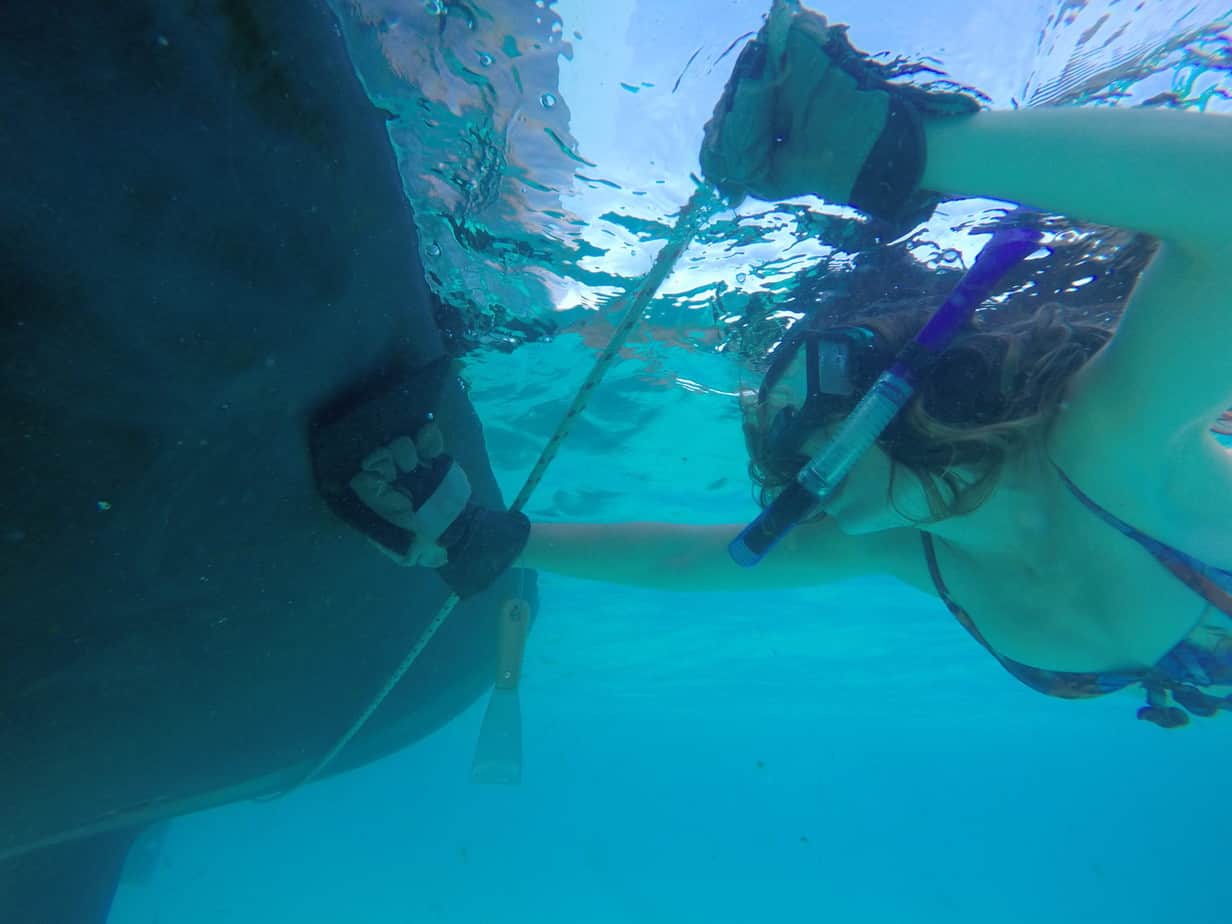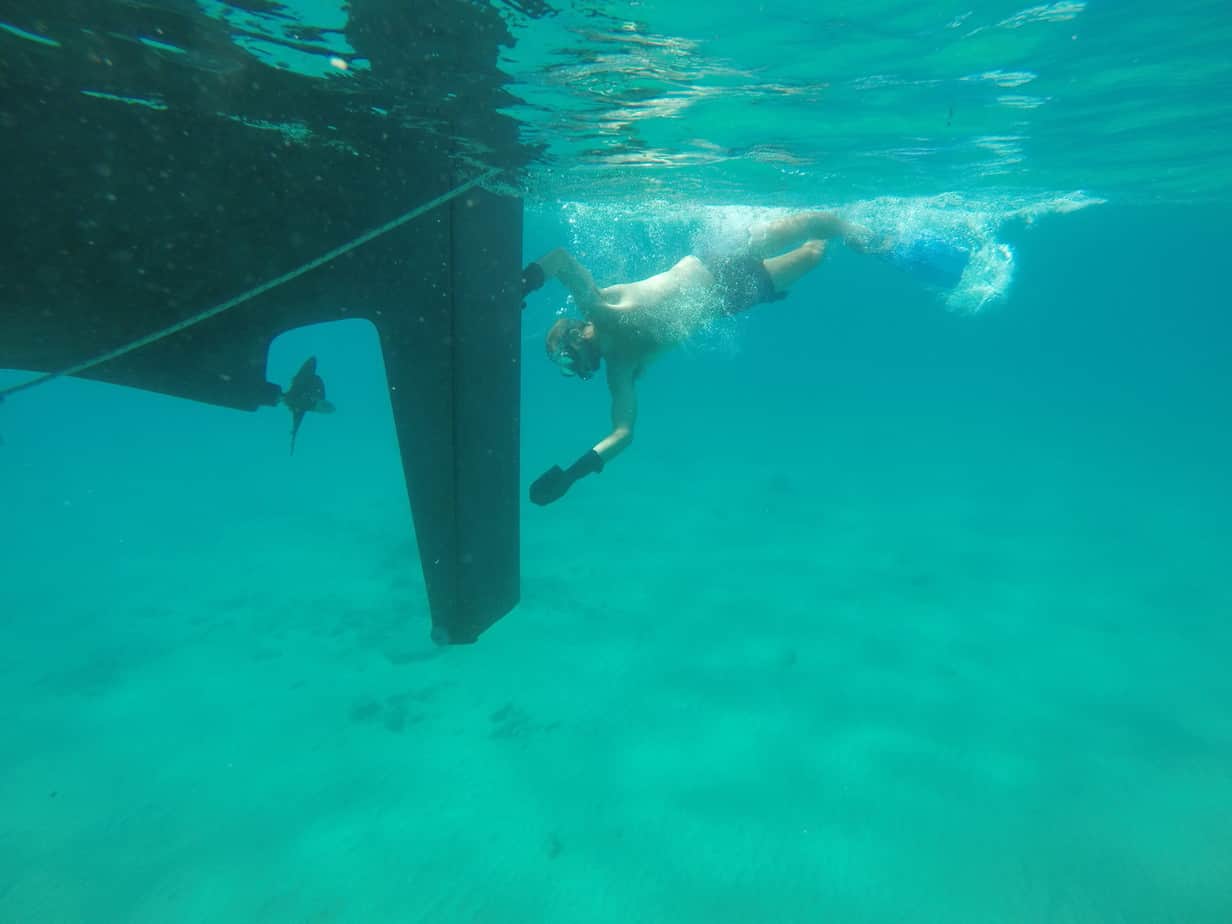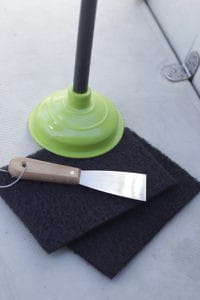How To Clean A Boat Bottom In The Water

Nosotros'd neglected the lesser of our boat for a month and the warm Mexican waters had transformed our sleek hull into a hirsuite ecosystem teeming with life. My partner, Robin, had begun naming the fish living underneath MonArk, our Dufour 35. Presumably, they'd mistaken us for a benevolent barnacle-encrusted whale, or worse, a coral reef! Information technology was time to clean the hull.
If y'all're looking to make clean the deck and hull (above the waterline), check out our post on these affordable bootleg boat cleaners.
We've learned over time that cleaning the lesser makes a existent difference when information technology comes to gunkhole speed,boat handling, and ensuring the lasting value of our floating dwelling house. A fouled bottom causes drag, which results in increased fuel consumption when under power and lower speeds under power or sail. This matters as much to cruisers every bit it does to racers, particularly when the speed reduction is factored over hundreds or thousands of miles.
Believe it or non, heavy fouling can actually crusade a boat to sit lower in the water. Afterward we clean the bottom, nosotros notice an improvement in our boat's motion through the water and she is more than responsive to the helm.
Some other reason to continue the lesser clean is that growth left unchecked for long periods can harm the hull. The "glue" produced by fouling organisms clinging to the hull can damage both wood and fiberglass.
While scrubbing the bottom remains my to the lowest degree-favorite gunkhole job, I've discovered it's possible to drastically reduce the effort it takes and the time we spend in the water by using the right tools and techniques. The first time we cleaned the bottom it took u.s.a. close to four human being hours; we've since got it down to less than 1 human hour. Today, it'south quite easy for us to maintain a clean bottom, and MonArk is no longer mistaken for a fish haven.
Types of fouling
Learning nearly the nature of the organisms that foul MonArk's hull and the mechanisms of different antifouling paints has helped the states refine our technique. Marine biologists approximate that there are more 4,000 known fouling species! They tin can exist broken down into three principal groups: animals, weeds,and slime. Animals include barnacles, mollusks, hydroids, and tube worms. They release millions of microscopic larvae into the water, all of which move around in currents, always looking to adhere themselves to stationary objects. Weeds accept varying characteristics. Many common seaweeds will simply autumn off the boat as before long as it moves, while others, like brown weed, are more than resilient and can withstand loftier boat speeds.
Slime is comprised of billions of single-cell algae that produce a syrupy medium in which to settle. Once established, they provide an ideal settling basis for more than algae. Coatings can grow quite quickly and remain on the hull every bit it moves through the water. As we sheet from identify to place, we've noticed the stuff we notice growing on MonArk's hull varies considerably.
Differences in h2o quality and temperature result in dissimilar species of fouling. Factors like nearby population centers, inflows from rivers and streams, the speed of currents, and the amount of sunlight bear upon the types and degrees of fouling in a region.
Antifouling paints
Boat bottom paint (aka antifouling paint) is made from a combination of four primary ingredients: biocide (repels living organisms), resin (holds the production together), solvent (dictates application characteristics and cleanup methods), and pigment (determines colour and viscosity). Whether an antifouling is soft (intended to ablate, erode, or slough off) or hard is adamant past the type, combination, and quantity of resin used in the mix. When cleaning a boat'southward underwater surfaces, information technology'due south important to lucifer the method to the type of antifouling on the hull. Ablative antifouling pigment sloughs away over time, dissolving equally h2o passes over the boat, taking whatsoever growth with it and revealing a fresh layer of biocide on the clean surface. Scrubbing ablative paint releases high concentrations of toxic material and drastically shortens the lifespan of the paint. It'southward best to gently sweep abroad fouling with a soft cloth and avert creating colored clouds of bottom paint. If the growth over an ablative paint does non release easily, it's likely adhering directly to the blank hull, which means it's time to booty out and repaint.
Hard paints dry out to a difficult, burnishable, and porous surface. They're chemically designed to leach biocide on contact with h2o to prevent fouling growth. Hard pigment may be scrubbed more than aggressively than ablative paint, but it'due south still important to apply the least-abrasive cloth that is effective at removing the growth.Bear in heed that scrubbing antifouling releases toxic fabric and, for that reason, many locales exercise not allow in-the-h2o bottom cleaning.

Tools, gear, and tricks
Over time, nosotros've learned that varying degrees of fouling and dissimilar areas of the boat crave us to have a multifariousness of tools at our disposal when cleaning MonArk'southward lesser.
Snorkeling gear – In addition to a snorkel, mask, and fins, I sometimes wearable a wetsuit and weight chugalug. Aught is more exhausting than trying to go on myself submerged when scrubbing a few feet underwater, and so attaining neutral buoyancy is helpful. Before going in, I e'er prime the inside of my mask with a dime-sized dollop of baby shampoo to forbid fogging.
Piece of work gloves – I clothing leather work gloves to go on me from bashing my knuckles or cutting myself on barnacles as I clean.
Plunger – Underwater, I'g weightless, so I use a toilet plunger to hold myself next to the hull while I scrub.
Hardwood scraper – Nosotros take a 2-foot length of 1 x 2-inch hardwood that nosotros run against the hull to scrape and knock away the majority of growth apace before moving on to . . .
Sponge, scrubbing pad, and castor – On lite growth, nosotros start with a sponge. If that's ineffective, we'll use a scrubbing pad or even a house-bristled scrubbing brush. Whichever tool it is, I apply one with the largest surface area practicable and so I tin cover more of the lesser in fewer strokes. We often use 3M Doodlebug Scrubbing Pads, which we tin find at most chandleries.
Putty knife – I employ a regular metal putty pocketknife to scrape tough barnacles and hard growth from unprotected metal such every bit the prop, the shaft, and the screen on the cooling-water intake for the engine.
Long skinny screwdriver – Small clams and other hard growth oft make their homes in the narrow through-hull passages. When I see a through-hull is obstructed, I carefully ream out the offending growth with a screwdriver.
Wire brush – Sacrificial anodes (zincs) are disquisitional to protecting underwater metal from stray currents simply are effective only when they're make clean. Growth will form on an anode that is not very active. The surface of an active anode accumulates a layer of oxide that looks like a white deposit. Anything on the surface of an anode, whether marine growth or oxide, will make it less effective and should exist cleaned off. A wire brush is an ideal tool for this.
Line – To save free energy and brand information technology easier to utilise pressure as we clean, Robin and I will sometimes use a line to catch onto and concord ourselves in place and against the boat. We run an old line, approximately a gunkhole length and a half long, from the bow, down one side of the boat and so information technology lies shut to where the keel meets the hull, and make it fast at the stern on the other side of the boat.
Scuba or hookah gear – After I earned my scuba certification, cleaning the gunkhole became physically easier. Not having to agree my jiff or swim up for air conserves a swell deal of energy. When I use the dive gear to clean the bottom, Robin will ever spot me from the gunkhole or join me in the water as a buddy diver for safety'southward sake.

A cleaning routine
Because working in the water is tiring, nosotros take developed a process for cleaning the lesser that is dependable and efficent.
Appraise the growth – Before donning my snorkel and fins, I want to know what I'm dealing with. Is it merely a green film, or are at that place barnacles and weeds? In warmer waters, nosotros frequently swim and snorkel around the boat at ballast, so I usually have a proficient thought of when it's time to make clean and what I'm facing.
Check the weather – Earlier I commit to cleaning the bottom, I accept note of currents, swell, traffic, and conditions. I try to avoid hull cleaning in areas with a lot of traffic, every bit MonArk's hull, all of a sudden rocking in a large ill-timed wake from a passing boat, can deliver a nasty knock to the head. Murky depression-visibility water is another reason to postpone a cleaning. Visibility is restricted enough when I'm wearing a mask, but when the water is dark or dirty, cleaning the bottom is even more difficult. Even in clear water, the difference in underwater visibility between the sunny side of the gunkhole and the shady side is significant. While I avoid working in strong currents, I find I tin sometimes use a weak current to assist me work my fashion downwards the length of the boat equally I make clean.
Lay out the tools – I never get in the h2o without first laying out — on the dock, swim platform, or dinghy — all the lesser-cleaning tools I might need where I can attain them from in the water. Where it makes sense, I tie string wristlets onto tools so I can loop them around my hands and non brand unintended gifts to Poseidon.
Make clean the waterline – Growth is often concentrated at the waterline, where information technology receives the nigh sunlight. Tackling this surface area from the dinghy tin save me a expert deal of energy specially when the water is cold. I simply pull myself in the dinghy effectually the gunkhole, cleaning the waterline as I go.
Disquisitional areas first – Often, I find I can spend only an hour in the h2o before I get too cold or too tired to go on, which makes information technology important to prioritize. Growth on the propeller and rudder has a greater affect on a boat's speed and responsiveness than fouling on other submerged areas. I ever start with our running gear.
From soft to abrasive – As I work my way around the rest of the boat, I start past running the piece of 1 x 2 hardwood lengthwise downward the sides of the hull to quickly remove large areas of growth. I so move on to sweeping with the sponge and, if necessary, more aggressive tools similar the pads, brush, and putty knife. By always using the least-aggressive ways needed to remove growth, we're preserving our paint and limiting the corporeality of biocide released into the bounding main.
Have a break – If growth is heavy, we'll opt to pause upwards the cleaning into multiple sessions. Between the cold, exertion, and swallowing a bit of seawater, information technology'due south very easy to become exhausted or disoriented. It's better to start with fifteen- to 30-minute sessions and not overdo it.
Don't wait likewise long – The best manner to keep bottom growth at bay is to make clean oft. Ideally, the growth would exist no more than nosotros can hands wipe away with a sponge. Frequency will differ by region (the warmer the climate, the faster stuff grows), paint condition and type (ablatives stay cleaner longer), and how the boat is used (boats that don't move accumulate more growth).
Over time, we've been able to dramatically reduce the time and effort we spend cleaning the hull, and that leaves us with more opportunities to use our snorkeling gear to explore more than scenic aquatic habitats!
This article was originally published in the Jul/Aug 2022 result of Good Old Boat mag. For more than articles on seamanship and boat diy, selection upwardly a subscription to Good Old Gunkhole.
Source: https://waterbornemag.com/clean-bottom-of-boat/
Posted by: titusshence1962.blogspot.com


0 Response to "How To Clean A Boat Bottom In The Water"
Post a Comment